Building control systems keep hospitals in sync
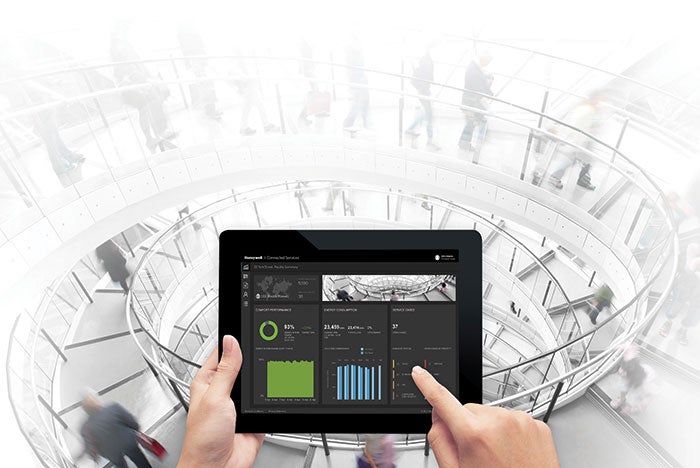
Hospitals are complex environments that can challenge the capabilities of the best building automation systems (BAS). These 24/7 facilities must maintain temperature, pressurization, humidity, lighting, life safety and security while meeting the comfort and safety needs of patients.
So, systems need to do more than deliver consistent environmental controls. They are expected to analyze data, predict challenges and respond to changing conditions as well as deliver reports in alignment with regulatory requirements.
Changes in health care
You may also like |
| Integrating building automation systems |
| Internet of Things transforms operations |
|
|
With patient satisfaction and healthy outcomes more closely tied to reimbursement, hospitals are seeking ways to improve the overall patient experience, and building performance is critical to that mission. The latest BAS can help facilities managers maintain optimal environments — providing a bird’s-eye view into system performance and impacting everything from climate control to security, and enabling a more comfortable experience for patients.
This sort of integration and central control becomes increasingly important in light of other changes happening within health care today, says Tracy Coppola, health care consultant, Honeywell Building Solutions, Morris Plains, N.J. “For example, we seldom see single-building hospitals. Most facilities are becoming large networks or enterprises spread across vast geographical footprints. With this transition, the challenge of managing many buildings is prevalent; however, with standardization and integration, this becomes more manageable and enables efficient day-to-day operations.”
Additionally, BAS are becoming the core infrastructure for smart hospitals. “Smart hospitals are doing away with siloed systems and incorporating intelligent BAS that not only can support energy efficiencies, but also can integrate with other key pieces of software,” says Warren Rosebraugh, director of solution architects, Schneider Electric, Andover, Mass.
Data collection is an important aspect of BAS. In fact, data analysis can help facilities to transition from following a preventive-maintenance strategy to a predictive one — timing maintenance to occur when warranted by equipment performance rather than by relying on fixed timetables or reactively addressing equipment failure. “By collecting the data and completing the analysis, facilities managers can schedule resources more efficiently, and have more flexibility to minimize impacts on patients and caregivers,” says Jerry Folsom, senior manager for health care solutions, Siemens’ Building Technologies Div., Buffalo Grove, Ill.
BAS evolution
The evolution of BAS has been impacted by technological advances that have taken place over the past 10 years, according to Gene Shedivy, BAS product leader, Trane, Davidson, N.C. “For example, the days of proprietary protocols are long gone. Controllers are now designed to support open standard protocols, which allow BAS to support a variety of protocols that connect to various types of systems in hospitals, including lighting, security, elevators and bed tracking.”
This integration of building systems can be supported by wireless technology, which has made this an increasingly vital option for hospitals. The Trane Air-fi wireless system operates on BACnet, which is an open standard communication protocol that allows users to integrate multiple HVAC systems and BAS — allowing for more effective hospital management.
“Integrating information from multiple systems can help a hospital when it wants to track key performance indicators in areas such as infection control, which can involve monitoring and controlling humidity levels and air changes in critical areas of the hospital. By continuously monitoring operating conditions and performance, facilities managers can quickly address potential problems before they become serious,” Shedivy adds.
Recently, health care facilities have upgraded to much faster processing and network speeds for room controls. Alarms, schedules and data collection are now moving at a much faster pace. “The Fieldbus system typically used to be a low-speed, 485-wire topology, but now it’s a Category 6 cable utilizing Ethernet, which provides for very fast processing and allows a hospital to run building operations more efficiently,” Rosebraugh notes.
The availability of low-cost metering of utilities enables heavy energy users such as hospitals to monitor down to a specific load, whether it be lighting, equipment or plug loads, according to Kevin Callahan, product owner and evangelist, Alerton, Lynwood, Wash. “Meters allow users to get very granular in their monitoring, and enable them to see where they may be wasting energy in the facility. The availability of metering, with reporting and an analytic framework, provides more information to managers, so they can narrow their scope toward reducing energy costs.”
The integration of clinical systems with BAS is another key to providing solutions to health care problems. “One example is how BAS can put patient rooms and surgical suites into an energy-saving, unoccupied mode based upon data received via integrations. Room temperature, airflow, lighting and blinds can be automatically adjusted to desired settings for times when the room is unoccupied. Clinical or operational team members can override the settings at any time by using wall-mounted devices such as light switches or thermostats,” Folsom says.
Many BAS advances have focused on energy management. Automated Logic, Kennesaw, Ga., has built energy management features into its WebCTRL BAS. Trim-and-respond functionality provides a sophisticated method of source-to-load optimization, according to Larry Scholl, regional technical consultant. For example, demand is generated at the zone, the patient room or operating room, which self-regulates the entire mechanical system to provide patient comfort and energy efficiency. The company’s PlantCTRL expands on the trim-and-respond function to control central plants within a hospital.
A key component of energy management is being able to access and understand the energy data being monitored and captured by BAS. “WebCTRL excels in this area by providing extensive dashboarding, reporting and trending capabilities that allow for diagnostic and efficiency analysis. It can interface to almost any system within a hospital, which allows these capabilities to extend to information from various building systems. Besides HVAC, common systems include lighting, electrical, fire and security,” Scholl explains.
Honeywell Building Solutions recently introduced Outcome Based Service, which is designed to help hospitals save energy. This cloud-enabled building management service identifies areas where hospitals can make energy improvements across campus by leveraging the data that buildings are constantly generating. For example, the service can detect opportunities to scale back energy use in unused patient rooms through measures such as reducing lighting or changing temperature settings.
Among other BAS introductions available to the health care field, the Trane Tracer Ensemble building management system provides an enterprisewide view into multiple building control systems, which allows users to manage schedules, setpoints and alarms across an entire enterprise. A user interface makes system control fast and easy, according to Shedivy.
“Tracer Ensemble features built-in reporting, which allows hospital personnel to manage and compare building performance in order to verify energy usage and savings. Custom dashboards allow users to create a visual display of current system health and performance. Ensemble also provides automatic report generation and archiving, which helps managers meet compliance and reporting requirements,” he adds.
Desigo CC integrated building management system (IBMS) from Siemens’ Building Technologies Div. provides easy integration of various components, which is important for large acute-care facilities and for health care systems that have multiple buildings. The system is designed to give facilities managers visibility and control across the enterprise.
Total room automation (TRA) is a new IBMS component that allows personnel to use a single controller to control lighting, shades and HVAC. Users are able to override pre-programmed settings and bring the space back into an energy-efficient mode. Similarly, patients can control the lighting and temperature in their rooms. “Room pressurization control in critical environments is a new TRA capability that allows laboratories to take advantage of the same lighting and temperature control available to patient rooms and offices,” Folsom says.
Ascent Compass supervisor software from Alerton is designed to reduce the amount of time spent managing and operating BAS. “With the health care field in mind, we recently developed a reporting feature within Compass that utilizes standard reporting templates in Microsoft SQL Server. It utilizes templates that make it easy to create standard reports on trend-logged data, alarms and energy,” Callahan says.
Custom templates can be created to meet the specific reporting needs of health care organizations and can be built to meet regulatory requirements such as Joint Commission reporting, Callahan adds. Standard or custom templates allow facilities managers to generate Joint Commission reports with a few mouse clicks, which saves hours of time over creating manual reports using pen and paper or Excel.
Schneider Electric recently introduced Clinical Environment Optimization to the health care market. Delivered as an application for its StruxureWare Building Operation software, the solution integrates a hospital’s clinical infrastructure with its facility infrastructure. It gives managers the ability to set flexible energy profiles for different departments or hospital areas based on patient occupancy, and to access comprehensive system audit-log and setback reports.
“This offering integrates with the electronic medical record, and admission, discharge and transfer systems. It can track the comings and goings of patients, occupancy of patient rooms and operating theaters. Also, the system is capable of setting back air exchanges or temperature setpoints based on occupancy, which drives energy savings,” Rosebraugh says.
The Metasys 9.0 building automation system from Johnson Controls Building Technologies & Solutions, Milwaukee, is an open integration platform that can bring together, monitor and control various systems and equipment that operate in hospitals. The company recently unveiled Metasys Enterprise Management, a cloud-based platform that analyzes building energy and equipment data. It identifies issues, faults and opportunities for improved performance, reduced energy consumption and lower energy costs.
“Powerful analytics root out energy- and equipment-related problems,” says Fawn Staerkel, director of health care, Johnson Controls. “These run in the background to find energy and equipment anomalies. Actionable information is provided through the fault detection and diagnostic feature while asset-maintenance software provides dashboards to display information and the status on work orders.”
Honeywell Building Solutions’ enterprise buildings integrator (EBI) R500 enables large hospitals to integrate multiple facilities without having to replace existing systems. “With EBI, facilities managers can easily manage and control building systems across a vast hospital network from a command center or mobile device, and access analytical insights to manage hospital operations and patient care. On top of preventive analytics, EBI triggers alarms,” Coppola says.
Continued connectivity
Experts envision more BAS connectivity as systems continue to evolve in the near future. Scholl sees more systems integration — a “single pane” that pulls all information from all building systems. “Too often, hospitals operate several separate system interfaces to run their facilities. The ultimate goal is to consolidate these silo systems into a single front end that does not require an expert.”
The power of the cloud for analytics is going to increase as well, Callahan predicts. Combined with the growth of artificial intelligence (AI), BAS will actually learn how a facility is operated and managed. “More data from the BAS and other systems will enable the analytical AI to gain intelligence. Ultimately, the system may be able to interact with the patient environment — adjusting room setpoints, dimming lights and operating window blinds.”
Neal Lorenzi is a freelance writer based in Mundelein, Ill.
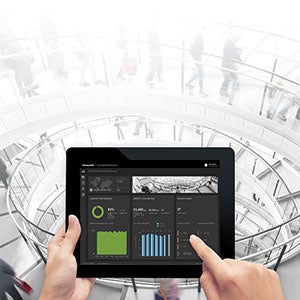
Team effort
Honeywell’s Outcome Based Service leverages a building’s connectivity to make an impact on overall building performance. Honeywell Building Solutions
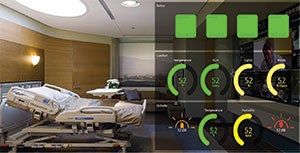
Complete package
Desigo CC total room automation allows personnel to use a single controller to control lighting, shades and HVAC. Siemens Building Technologies Div.
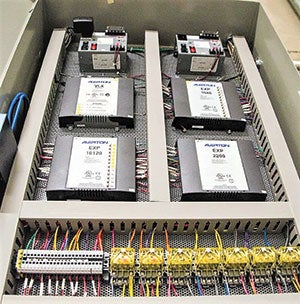
All systems go
Ascent building automation system enables control of multiple building systems, including HVAC and lighting. Alerton
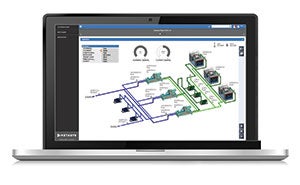
User friendly
The intuitively designed Metasys user interface offers enhanced operator efficiency. Johnson Controls
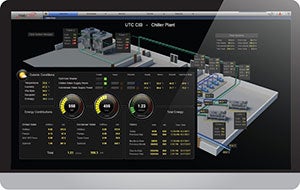
Data dive
WebCTRL provides extensive dashboarding, reporting and trending capabilities that allow for diagnostic and efficiency analysis. Automated Logic
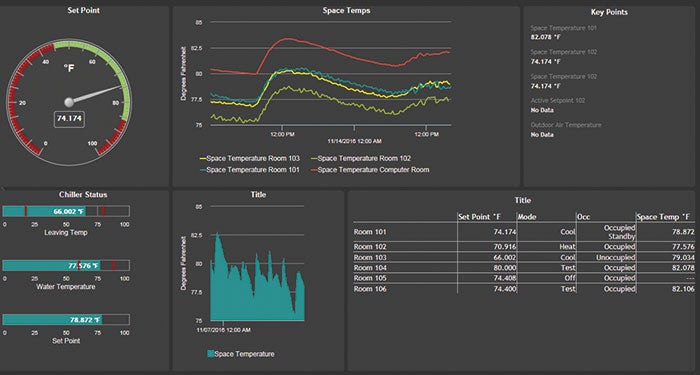
Reliable source
Tracer Ensemble provides automatic report generation and archiving as well as global functionality. Trane




